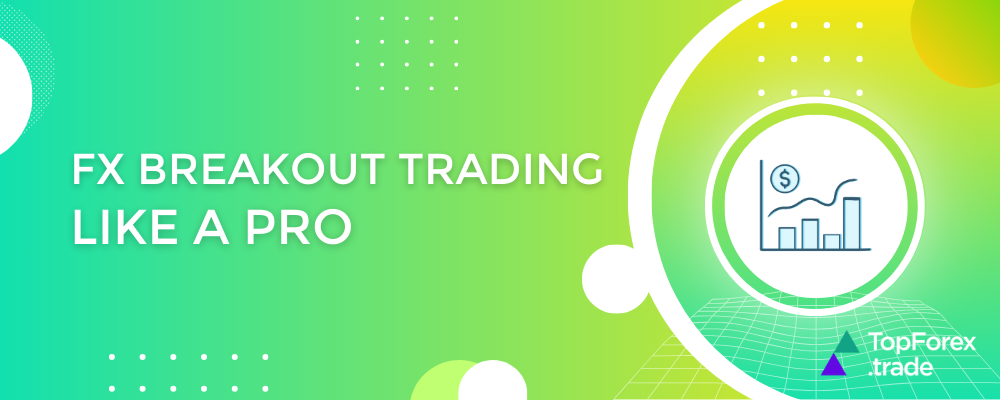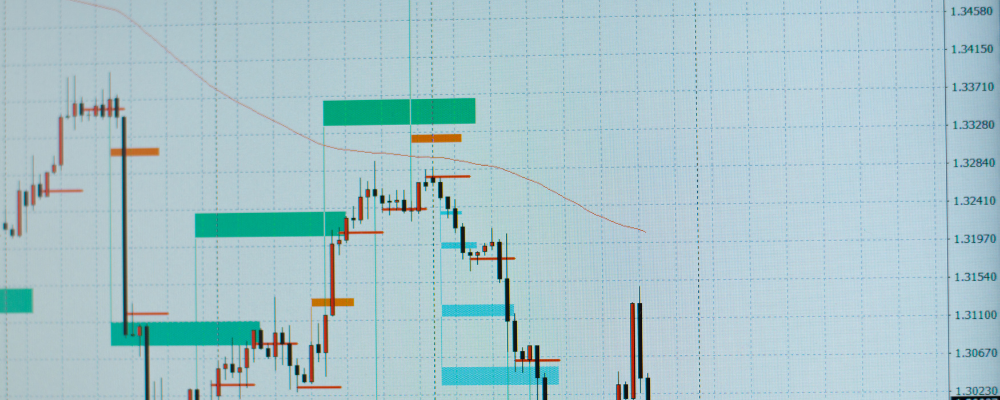Breakout trading guide: key indicators and best Forex brokers

Breakout trading involves identifying when a price moves beyond a key level, such as support or resistance, signaling a potential shift in market momentum. In this article, we’ll explore how to recognize these moments, how to enter trades with precision, and the best ways to manage risk. This approach offers a structured way to capitalize on market movements, and we’ll guide you through the process step by step.
What is a breakout in FX trading?
A breakout occurs when the price moves beyond a well-defined support or resistance level with increased volume. This move signals a potential price continuation in the breakout direction, often leading to strong trends.
✅ Types of breakouts
- Continuation breakouts: Occur during a trend when the price consolidates before breaking out in the direction of the trend (e.g., bull/bear flags).
- Reversal breakouts: Price breaks out against the existing trend, signaling a potential trend reversal.
- Range breakouts: When the price has been trading sideways (within a range) and then breaks out above resistance or below support.
➡Example:
- If EUR/USD has been trading in a range between 1.0800 and 1.0900, a breakout above 1.0900 or below 1.0800 can signal a new trend direction.
How to recognize breakouts in FX trading

1️⃣ Identifying key support and resistance levels
A strong breakout occurs when the price moves beyond significant support or resistance levels. To identify these levels:
2️⃣ Check past highs and lows (swing points)
➡ Example: EUR/USD resistance breakout
- EUR/USD has been struggling to break above 1.1000 for weeks.
- Each time it reaches this level, it reverses downward.
- If the price suddenly breaks above 1.1000 with high volume, this signals a breakout.
✔ Breakout confirmation: A strong green (bullish) candlestick closing above 1.1000 confirms the breakout.
3️⃣ Identify support and resistance zones
➡ Example: BTC/USD Range Breakout
- Bitcoin has been stuck between $30,000 (support) and $32,000 (resistance) for a month.
- If BTC moves above $32,000 with strong buying pressure, it signals a breakout.
✔ Trading plan:
- Buy when BTC closes above $32,000.
- Stop-loss below $31,500 (to protect against a false breakout).
- Target at $34,000 for a 2:1 risk-reward ratio.
4️⃣ Use trendlines to spot dynamic breakouts
➡ Example: Gold uptrend breakout
- Gold has been following an upward trendline, bouncing off higher lows.
- If it suddenly breaks above the trendline with strong momentum, it confirms a breakout.
✔ Trading plan:
- Buy when price breaks above trendline.
- Stop-loss below the trendline.
- Target at the next key resistance level.
Common breakout patterns and examples
1️⃣ Triangle breakouts (ascending, descending, symmetrical) – price squeezes into a tighter range before breaking out.
➡ Example: Apple Stock (AAPL) ascending triangle breakout
- AAPL has been forming higher lows, creating an ascending triangle below $200 resistance.
- If price breaks above $200, it signals a bullish breakout.
✔ Trade: Enter long at $201, stop-loss at $195, target at $210+.
2️⃣ Rectangles (range breakouts) – the price moves sideways in a range before breaking up or down.
➡ Example: S&P 500 Index consolidation breakout
- S&P 500 has been moving sideways between 4,300 and 4,500.
- If it breaks above 4,500, a new bullish trend may start.
✔ Trade: Buy above 4,505, stop-loss below 4,450, target 4,600+.
3️⃣ Flags and pennants (trend continuation breakouts) – a brief pause after a strong price move, followed by a continuation in the same direction.
➡ Example: Tesla Stock (TSLA) flag breakout
- TSLA surged from $200 to $250, then consolidated in a small flag pattern.
- If it breaks above $255, it signals a continuation of the uptrend.
✔ Trade: Enter at $256, stop at $248, target at $270.
4️⃣ Head and Shoulders (trend reversal breakouts) – a reversal pattern where the price forms three peaks, signaling a potential trend change.
➡ Example: USD/JPY Head & Shoulders Breakdown
- USD/JPY forms a head and shoulders pattern at 145.00.
- If it breaks below the neckline at 144.50, it signals a downtrend.
✔ Trade: Sell at 144.40, stop at 145.10, target at 143.00.
Volume confirmation: avoid false breakouts

Volume is key in breakout trading. A real breakout is accompanied by high volume, while a false breakout usually lacks strong participation.
How to confirm volume:
📌 Use the Volume Indicator: If a breakout occurs with low volume, it’s likely a false breakout.
📌 Use VWAP (Volume-Weighted Average Price): Helps gauge whether institutional players are involved.
📌 Combine with On-Balance Volume (OBV): Confirms the strength of price movements.
Candlestick patterns for confirmation:
When price reaches a key level, watch for confirmation using candlestick patterns:
✅ Strong breakout candle (full-bodied, no long wicks)
✅ Retest candle (after the breakout, price tests the previous level)
✅ Engulfing candle (shows strong momentum in breakout direction)
🚨 Warning signs of false breakouts:
❌ A long wick rejecting the breakout level
❌ Low volume on the breakout
❌ A quick reversal after the breakout
How to enter FX trades with precision
1. Entering on breakout confirmation
📌 Aggressive entry: Enter as soon as the price breaks the key level with volume confirmation. This allows you to ride the momentum early.
📌 Retest entry: Wait for the price to retest the breakout level before entering. This reduces the risk of false breakouts.
Example:
- BTC/USD breaks above $30,000 resistance → wait for a pullback to $30,000 before entering long.
Using technical indicators for confirmation

✅ Moving Averages (20 EMA, 50 EMA, 200 EMA): Price breaking above/below these levels signals strong momentum.
✅ Bollinger Bands: Breakouts that coincide with a Bollinger Band expansion indicate strong volatility.
✅ RSI (Relative Strength Index): A breakout with RSI moving above 70 (bullish) or below 30 (bearish) confirms momentum.
✅ MACD (Moving Average Convergence Divergence): A bullish MACD crossover supports a long breakout, while a bearish crossover confirms a short breakout.
Risk management strategies for breakout trading
Even the best setups can fail, so risk management is essential to protect your capital.
1. Stop-loss placement: where to exit if the trade fails
🚨 Where to place stop-losses:
✅ Below (for longs) or above (for shorts) the breakout level
✅ Use ATR (Average True Range) to determine stop distance
✅ Below the previous swing low (for long trades) or above the previous swing high (for short trades)
Example:
- If GBP/USD breaks above 1.2500, place the stop-loss at 1.2480 (below the breakout level).
2. Position sizing: controlling risk per trade
📌 Risk only 1-2% of your total capital per trade
📌 Adjust lot size based on stop-loss distance
📌 Use Risk-to-Reward Ratio (R:R) of at least 1:2 to maximize profitability
Example:
- If your stop-loss is 50 pips, aim for a 100-pip target for a 1:2 risk-reward ratio.
3. Profit targets: when to exit winning trades
✅ Measure the height of the previous range and use it as a target.
✅ Partial profit-taking: Secure profits at key levels while letting the rest of the trade run.
✅ Use a trailing stop: Adjust stop-loss as the trade moves in your favor to protect gains.
Example:
- If USD/JPY breaks out from a 50-pip range, set a target 50 pips away from the breakout level.
Breakout trading example: EUR/USD

Market setup:
Let’s say EUR/USD has been trading in a range between 1.1000 (support) and 1.1100 (resistance) for several days. This range has held strong, but the price has recently started showing signs of higher volatility, suggesting a breakout might be imminent.
➡ Step 1: Identifying the breakout
Support and resistance levels:
- Support at 1.1000
- Resistance at 1.1100
This range has been tested multiple times, with price bouncing off these levels. Breakouts often occur after a consolidation phase like this.
Volume confirmation:
- On the 4-hour chart, we see a significant increase in volume as the price approaches the resistance level at 1.1100. This suggests that a breakout may happen soon.
Candlestick confirmation:
- A bullish engulfing candle forms as the price touches the 1.1100 resistance. This is a strong signal of potential upward momentum.
➡ Step 2: Entering the trade
Trigger for entry:
You decide to enter the trade as soon as the price breaks above 1.1100 with high volume and a strong bullish candle. The breakout is confirmed by:
- Price closing above 1.1100 on the 1-hour chart.
- Volume is significantly higher than the previous candles, showing strong market participation.
Entry position:
- Buy EUR/USD at 1.1105 (just above the breakout point to avoid entering too early).
- Stop-loss: Place the stop-loss at 1.1080, just below the breakout level of 1.1100. This accounts for the market noise and protects you if the breakout fails (a false breakout).
Target:
- Target: Measure the range of the consolidation (1.1100 – 1.1000 = 100 pips). Set a target of 1.1205 (100 pips above the breakout point). This provides a 1:2 risk-to-reward ratio.
➡ Step 3: Managing the trade
Risk management:
-
Position size: If your account balance is $10,000 and you risk 2% per trade, you would risk $200 on this trade. Since your stop-loss is 25 pips (from 1.1105 to 1.1080), calculate your position size as follows:
- $200 / 25 pips = 8 units per pip (8,000 units, or 0.08 lots in standard terms).
Exit strategy:
- If the price moves in your favor and reaches 1.1150, consider locking in profits by moving your stop-loss to break-even (1.1105).
- Once the price reaches 1.1205, your target, exit the trade to capture the full profit.
Alternatively, if the price shows signs of reversal (such as a bearish engulfing candle or a significant drop in volume), you can close part of the position early to lock in profits.
➡ Step 4: Trade outcome
Let’s assume that after entering at 1.1105, EUR/USD rallies and hits your target at 1.1205. This means you’ve made a 100 pip profit with a 1:2 risk-to-reward ratio.
Trade recap:
- Entry: Buy EUR/USD at 1.1105
- Stop-Loss: Set at 1.1080
- Take Profit: Set at 1.1205
- Risk-to-Reward Ratio: 1:2
- Outcome: Target hit at 1.1205, resulting in a 100 pip profit.
Best Forex brokers for breakout trading
Breakout trading requires fast execution, tight spreads, and reliable platforms to capitalize on rapid price movements. Here are some of the best forex brokers for breakout traders:
HF Markets (HFM)
✔ Tight spreads and fast execution – Ideal for catching breakouts without slippage.
✔ MetaTrader 4 and 5 support – Advanced charting tools for spotting breakouts.
✔ Zero-commission accounts – Low-cost trading for active breakout traders.
✔ VPS hosting – Ensures uninterrupted trading for algorithmic breakout strategies.
🔹 Best for: Traders looking for fast execution and low trading costs.
Exness
✔ Ultra-low spreads – As low as 0.0 pips for major pairs like EUR/USD.
✔ No slippage on limit orders – Perfect for breakout entry strategies.
✔ High leverage options – Amplify potential breakout gains.
✔ Instant order execution – Ideal for scalping and breakout trading.
🔹 Best for: Scalpers and high-frequency traders using breakout strategies.
AvaTrade
✔ Fixed and floating spreads – Choose between stability and lower costs.
✔ Regulated across multiple jurisdictions – Safe for serious traders.
✔ Advanced charting tools – Built-in indicators for breakout recognition.
✔ MT4, MT5, and AvaTradeGO – Multiple platforms for mobile and desktop trading.
🔹 Best for: Traders who want flexibility with both fixed and floating spreads.
BlackBull Markets
✔ Raw ECN spreads from 0.0 pips – Tight pricing for breakout entries.
✔ Ultra-fast execution with fiber-optic connections – No lag on breakout moves.
✔ Institutional-grade liquidity – Ensures minimal slippage.
✔ Advanced trading tools and VPS support – Ideal for EA-based breakout trading.
🔹 Best for: Traders looking for institutional-level execution and spreads.
XTB
✔ Proprietary xStation 5 platform – Lightning-fast execution speed.
✔ No minimum deposit – Great for traders starting with small accounts.
✔ Low spreads and deep liquidity – Ensures tight bid-ask prices on breakouts.
✔ Advanced risk management tools – Helps manage stop-loss levels effectively.
🔹 Best for: Traders who prefer a high-tech platform with great execution speed.
Related articles:
Forex breakout trading - FAQ